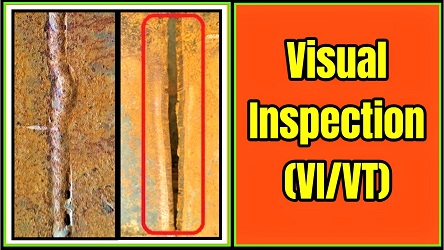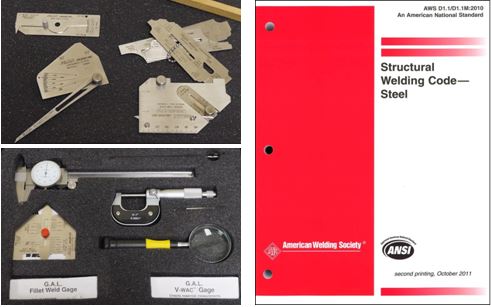How to Make Sure Quality with Welding Inspection Gilbert Arizona: Ideal Practices
How to Make Sure Quality with Welding Inspection Gilbert Arizona: Ideal Practices
Blog Article
Discovering the Significance of Welding Evaluation in Industrial Applications: Guarding Versus Failures and Enhancing Durability
Welding assessment offers as an important line of defense in commercial applications, making sure the structural stability and integrity of bonded parts. By methodically recognizing flaws such as porosity and incomplete blend, evaluations not just avoid failures however likewise expand the lifespan of important assets.
Role of Welding Examination
Welding inspection works as an essential safeguard in commercial applications, making sure that bonded structures satisfy defined standards of top quality and safety and security. This process entails a systematic exam of welds to confirm their stability, strength, and conformity with established codes and requirements. The function of welding evaluation is multifaceted, including both aesthetic assessments and non-destructive testing techniques, which may consist of ultrasonic, radiographic, or magnetic particle testing.

Furthermore, welding examination plays a crucial role in regulative conformity. Eventually, the duty of welding evaluation is crucial in promoting safety and security, improving performance, and securing financial investments in industrial facilities.
Typical Welding Problems

Among the most widespread flaws is porosity, identified by tiny gas pockets entraped within the weld metal. This takes place because of contaminants or improper protecting gas, compromising the weld's toughness. One more significant flaw is insufficient blend, where the weld metal stops working to bond appropriately with the base product, possibly leading to structural weaknesses.
Splits can likewise develop throughout or after the welding process, commonly attributed to thermal stresses or inappropriate cooling prices. Furthermore, undercutting, where the base steel is eroded along the weld bead, can weaken the joint and is often brought on by too much warm input or incorrect strategy.
Additionally, lack of penetration happens when the weld steel does not get to the root of the joint, bring about poor toughness. Comprehending these typical issues is essential for examiners and welders alike to make certain that welded frameworks meet safety and efficiency criteria, ultimately preventing potential failures in industrial applications.
Benefits of Routine Evaluations
Routine assessments work as a vital guard in guaranteeing the integrity and longevity of bonded frameworks. These evaluations determine prospective issues and weaknesses that might jeopardize the integrity of welds, enabling prompt remediation prior to concerns rise. By executing an organized assessment routine, organizations can significantly lower the danger of disastrous failures that may result in pricey downtime, devices substitute, or even accidents.
Furthermore, normal inspections add to enhanced quality control throughout the welding process. By adhering to a consistent inspection schedule, companies can make certain that their welding practices meet recognized high quality standards and finest practices. This not only fosters a society of responsibility however likewise urges constant enhancement amongst welding personnel.
In enhancement, normal evaluations facilitate better upkeep planning. By identifying damage early, organizations can purposefully arrange substitutes and repairs, lessening interruption to procedures. This proactive method inevitably brings about extended property life expectancy and improved general performance.
Lastly, a dedication to normal inspections can improve a firm's credibility in the industry. Customers and stakeholders progressively worth companies that prioritize safety and quality, thus boosting trust fund and potentially bring about boosted service chances.
Sector Specifications and Rules
Adhering to sector criteria and regulations is a fundamental facet of welding evaluation that enhances the benefits of normal evaluations. These standards, established by organizations such as the American Welding Society (AWS) and the American Culture of Mechanical Designers (ASME), supply a structure for ideal methods in welding processes, materials, and examination techniques. Conformity with these policies makes sure that welds meet the called for high quality and safety benchmarks, dramatically reducing the threat of structural failures.
Regulative bodies like the Occupational Safety And Security and Wellness Management (OSHA) better apply standards that secure employees and the setting throughout welding operations. By adhering to these developed requirements, markets can boost the dependability of their parts and frameworks, guaranteeing they execute as intended under various operational problems.
Additionally, adherence to sector requirements promotes uniformity in quality assurance, promoting smoother communication among stakeholders and governing companies. This placement not just decreases responsibility dangers but additionally improves the integrity of companies in open markets. Ultimately, conformity with welding standards and laws is not simply a lawful responsibility; it is an essential investment in safety and security, efficiency, and lasting operational success.
Future Trends in Welding Assessment
As sectors remain to advance, the future of welding evaluation is poised to incorporate innovative technologies that improve precision and performance. One of one of the most significant trends is the adoption of automation and robotics in examination processes. Automated systems can carry out inspections quickly, lowering human mistake and enhancing throughput in producing atmospheres.
In addition, the integration of expert system (AI) and artificial intelligence algorithms will enable predictive analytics, enabling for real-time analyses and positive maintenance (Welding Inspection Gilbert Arizona). By examining information from previous inspections, click this these innovations can determine patterns that can suggest possible failings, therefore expanding the lifespan of bonded elements

Moreover, the fad towards digitalization will certainly cause enhanced data management systems that facilitate better monitoring, reporting, and conformity with industry standards. In summary, the future of welding assessment is identified by technical advancements that promise to considerably boost reliability, safety and security, and functional performance in various industrial applications.
Final Thought
In final thought, welding examination offers a crucial function in ensuring the stability and resilience of bonded see frameworks across numerous commercial applications. By recognizing issues such as porosity and insufficient fusion, normal examinations play a considerable function in risk mitigation and quality control. Adherence to sector standards and laws better enhances operational security and reliability. As innovations in technology remain to develop, the future of welding assessment promises increased accuracy and effectiveness, eventually adding to the longevity of crucial facilities.
Welding examination serves as browse this site a critical line of protection in commercial applications, guaranteeing the structural integrity and integrity of welded parts.Welding examination serves as an essential safeguard in industrial applications, guaranteeing that bonded frameworks meet defined requirements of quality and safety - Welding Inspection Gilbert Arizona. Ultimately, the duty of welding evaluation is crucial in promoting security, enhancing efficiency, and protecting financial investments in industrial infrastructure
These criteria, developed by companies such as the American Welding Culture (AWS) and the American Culture of Mechanical Designers (ASME), supply a framework for finest techniques in welding procedures, materials, and examination techniques.In conclusion, welding inspection serves a vital function in making sure the integrity and longevity of welded structures throughout various industrial applications.
Report this page